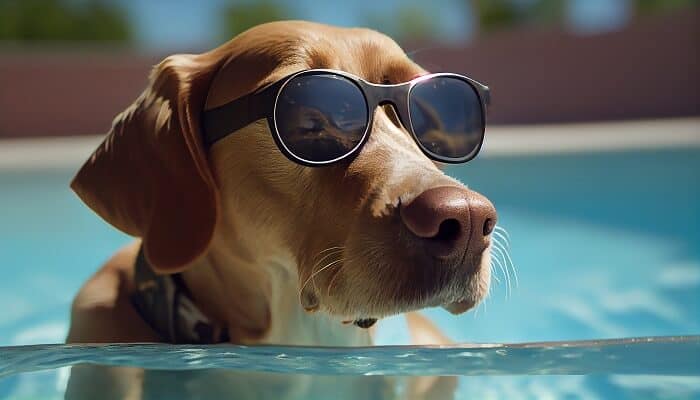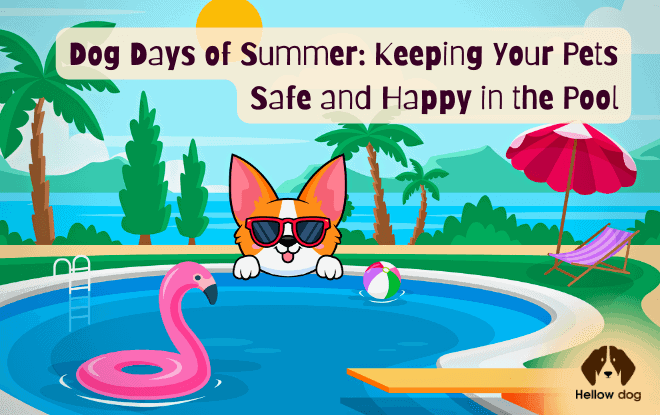Summer is a great time to enjoy the pool with your furry friends. However, as much fun as swimming can be, it’s important to be aware of the potential dangers and take steps to keep your pets safe. In this article, we’ll explore five swimming pool pet dangers and how to prevent them.

Swimming Pool Pet Dangers
1. Drowning
Drowning is one of the most serious dangers for pets in the pool. Even dogs that are good swimmers can tire or become disoriented, leading to a potentially fatal accident.
2. Chemical Exposure
The chemicals used to treat swimming pools can be harmful to pets if ingested or absorbed through the skin. This includes chlorine and other sanitizers, as well as algaecides and pH balancers.
3. Heat Exhaustion
Pets can also be at risk of heat exhaustion in hot weather, especially when playing in the pool. This can lead to dehydration, overheating, and other serious health issues.
4. Slip and Fall Accidents
Wet pool decks and slippery surfaces can lead to slip-and-fall accidents for pets. This can lead to injuries such as sprains, fractures, or even head trauma.
5. Dangers from Pool Equipment
Pool equipment such as pumps, filters, and heaters can pose a danger to pets. Pets may become entangled in cords or suffer from electrical shock.

Tips for Preventing Swimming Pool Pet Dangers
1. Teach Your Dog to Swim
If your dog is not a natural swimmer, it’s important to teach them how to swim before allowing them in the pool. This can include using a life jacket or floatation device to provide extra support.
2. Secure the Pool Area
To prevent pets from accidentally falling into the pool, be sure to secure the pool area with a fence or other barrier. It’s also important to supervise pets at all times while they are in the pool area.
3. Rinse Your Pet After Swimming
After swimming in the pool, be sure to rinse your pet off with fresh water to remove any chemicals or debris from their fur.
4. Provide Shade and Water
To prevent heat exhaustion, provide plenty of shade and fresh water for pets while they are playing in the pool area. It’s also important to take regular breaks to allow pets to rest and cool down.
5. Store Pool Equipment Safely
To prevent accidents with pool equipment, be sure to store cords and other equipment safely out of the reach of pets. It’s also important to keep equipment in good repair and to check for any potential hazards regularly.
Fun Activities for Swimming with Your Pet
1. Fetch
Many dogs love to play fetch, and swimming can add an exciting new element to this classic game. Just make sure to use toys that are safe for the water and that your pet can easily retrieve.
2. Agility Courses
If your dog is a more experienced swimmer, consider setting up an agility course in the pool area. This can include obstacles such as floats, hoops, and ramps, and can provide a fun and challenging workout for your pet.
3. Relaxing Floats
For dogs that prefer a more relaxing swimming experience, consider providing a pool float or raft for them to lounge on. This can provide a comfortable and stress-free way for your pet to enjoy the pool.
Conclusion
Swimming can be a fun and enjoyable activity for pets, but it’s important to be aware of the potential dangers and take steps to prevent them. By teaching your dog to swim, securing the pool area, rinsing your pet after swimming, providing shade and water, and storing pool equipment safely, you can help ensure a safe and happy summer for your furry friends.
FAQs
- Can all dogs swim?
Not all dogs are natural swimmers, and some may require extra training or support. However, most dogs can learn to swim with practice and patience.
- How can I tell if my pet is experiencing heat exhaustion?
Signs of heat exhaustion in pets may include excessive panting, lethargy, vomiting, and diarrhea. If you suspect your pet may be experiencing heat exhaustion, it’s important to seek veterinary care immediately.
- Can pool chemicals harm my pet if they drink pool water?
Yes, pool chemicals can be harmful if ingested by pets. It’s important to prevent pets from drinking pool water and to rinse them off with fresh water after swimming.
- How can I prevent slip and fall accidents around the pool?
To prevent slip and fall accidents, ensure that the pool deck and surrounding areas are free of debris and kept dry. You can also use slip-resistant mats or coatings to improve traction.
- What types of dogs are best suited for swimming?
Many breeds of dogs are well-suited for swimming, including retrievers, spaniels, and water dogs. However, any dog can potentially enjoy swimming with proper training and supervision.
- Can swimming be a form of exercise for dogs?
Yes, swimming can be an excellent form of exercise for dogs, as it provides a low-impact workout that can help improve cardiovascular health and muscle tone.
- How often should I rinse my pet off after swimming?
It’s a good idea to rinse your pet off with fresh water after each swim to remove any chemicals or debris from their fur. This can help prevent skin irritation and other health issues.
- Can I let my pet swim in any body of water?
Not all bodies of water are safe for pets to swim in. It’s important to research the safety of a body of water before allowing your pet to swim, as some may contain harmful bacteria or other hazards.







